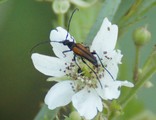Підтримуємо Вільну Україну
 We Support Free Ukraine
We Support Free Ukraine

Biodiversity Map
Taxa

Stenurella — subordinate taxa:
Taxon count: 1
-
Arthropodaphylum
Click to switch
to select orders
and filters > -
Hexapodasubphylum
Click to switch
to select orders
and filters > -
Insectaclass
Click to switch
to select orders
and filters > -
Coleopteraorder
Click to set
as the main taxon
and as a base
← of the left panel > -
Polyphagasuborder
Click to set
as the main taxon
and as a base
← of the left panel > -
Cucujiformiaseries
Click to set
as the main taxon
and as a base
← of the left panel > -
Chrysomeloideasuperfamily
Click to set
as the main taxon
and as a base
← of the left panel > -
Cerambycidaefamily
Click to set
as the main taxon
and as a base
← of the left panel > -
Lepturinaesubfamily
Click to set
as the main taxon
and as a base
← of the left panel > -
Lepturinitribe
Click to set
as the main taxon
and as a base
← of the left panel > -
Stenurellagenus
Click to set
as the main taxon
and as a base
← of the left panel > -
Stenurellasubgenus
Click to set
as the main taxon
and as a base
← of the left panel > -
Stenurella melanuraspecies
Click to set
as the main taxon
and as a base
← of the left panel >
PL
YES
name status: valid name
BioMap ID: 1064073
taxon code: 4092
taxonomy checked: YES
Data on distribution in Poland

Statistics
- Records: 1124
- Publications: 234
- Collections: 35
- Publication authors: 212
- Illustrations (iconography): 1
- Photos (specimen/observation): 3
Taxon description
Rozprzestrzeniony prawie w całej Europie (prócz północnych prowincji Fennoskandii), docierający na wschód przez Syberię Zachodnią do północnej Mongolii i Zabajkala, notowany też z Kaukazu. W Polsce występuje od Bałtyku aż po Tatry i jest najpospolitszym gatunkiem omawianego rodzaju, ale stosunkowo rzadko notowanym z poszczególnych krain. Postacie dojrzałe ukazują się w czerwcu i występują do sierpnia. W pogodne dni pobierają pokarm na kwiatach różnych gatunków roślin, należących głównie do baldaszkowatych — Umbelliferae, złożonych — Compositae i różowatych — Rosaceae. Samica składa jaja w szczeliny kory i drewna w przykorzeniowej części martwych lub obumierających cienkich drzew, zarówno iglastych, jak i liściastych. Larwy żerują w butwiejącym i zmurszałym drewnie, drążąc chodniki równoległe do osi pnia. Jednoroczny cykl rozwojowy może być przedłużony do dwóch lat.
Illustrations
... browse
 Stenurella
Stenurellamelanura
melanura
External data sources
- Ostatnie rekordy
-
1148694
 ⊡
⊡ Cerambycidae: Stenurella melanura melanura, PL, Wyżyna Małopolska, Nizina Południowomazowiecka, Równina Radomska, łódzkie, Opoczno, Drzewica, Rożek, UTM DB69, 2023, leg. M. Miłkowski
Cerambycidae: Stenurella melanura melanura, PL, Wyżyna Małopolska, Nizina Południowomazowiecka, Równina Radomska, łódzkie, Opoczno, Drzewica, Rożek, UTM DB69, 2023, leg. M. Miłkowski -
1148547
 ⊡
⊡ Cerambycidae: Stenurella melanura melanura, PL, Michnówka, UTM FD73, 1983 (Gutowski et Kubisz 1995)
Cerambycidae: Stenurella melanura melanura, PL, Michnówka, UTM FD73, 1983 (Gutowski et Kubisz 1995) -
1148294
 ⊡
⊡ Cerambycidae: Stenurella melanura melanura, PL, Pobrzeże Bałtyku, Świnoujście, UTM VV57, 2002 (Wolender et Zych 2007)
Cerambycidae: Stenurella melanura melanura, PL, Pobrzeże Bałtyku, Świnoujście, UTM VV57, 2002 (Wolender et Zych 2007) -
1148231
 ⊡
⊡ Cerambycidae: Stenurella melanura melanura, PL, Wyżyna Małopolska, Nizina Południowomazowiecka, Równina Radomska, mazowieckie, Lipsko, Rzeczniów, Kolonia Rogalin, UTM EB36, 2022, leg. M. Miłkowski
Cerambycidae: Stenurella melanura melanura, PL, Wyżyna Małopolska, Nizina Południowomazowiecka, Równina Radomska, mazowieckie, Lipsko, Rzeczniów, Kolonia Rogalin, UTM EB36, 2022, leg. M. Miłkowski -
1148209
 ⊡
⊡ Cerambycidae: Stenurella melanura melanura, PL, Wyżyna Małopolska, Nizina Południowomazowiecka, Dolina Białobrzeska, mazowieckie, Grójec, Mogielnica, Tomczyce, UTM DC71, 2022, leg. M. Miłkowski
Cerambycidae: Stenurella melanura melanura, PL, Wyżyna Małopolska, Nizina Południowomazowiecka, Dolina Białobrzeska, mazowieckie, Grójec, Mogielnica, Tomczyce, UTM DC71, 2022, leg. M. Miłkowski -
1148195
 ⊡
⊡ Cerambycidae: Stenurella melanura melanura, PL, Nizina Mazowiecka, Nizina Środkowomazowiecka, Równina Kozienicka, mazowieckie, Kozienice, Garbatka-Letnisko, Żytkowice, UTM EC30, 2022, leg. M. Miłkowski
Cerambycidae: Stenurella melanura melanura, PL, Nizina Mazowiecka, Nizina Środkowomazowiecka, Równina Kozienicka, mazowieckie, Kozienice, Garbatka-Letnisko, Żytkowice, UTM EC30, 2022, leg. M. Miłkowski -
1148132
 ⊡
⊡ Cerambycidae: Stenurella melanura melanura, PL, Nizina Wielkopolsko-Kujawska, Pojezierze Lubuskie, Równina Torzymska, lubuskie, Słubice, Słubice, UTM VT79, 2022, leg. M. Adamski
Cerambycidae: Stenurella melanura melanura, PL, Nizina Wielkopolsko-Kujawska, Pojezierze Lubuskie, Równina Torzymska, lubuskie, Słubice, Słubice, UTM VT79, 2022, leg. M. Adamski -
1148131
 ⊡
⊡ Cerambycidae: Stenurella melanura melanura, PL, Nizina Wielkopolsko-Kujawska, Pojezierze Lubuskie, Równina Torzymska, lubuskie, Słubice, Słubice, UTM VT79
Cerambycidae: Stenurella melanura melanura, PL, Nizina Wielkopolsko-Kujawska, Pojezierze Lubuskie, Równina Torzymska, lubuskie, Słubice, Słubice, UTM VT79 -
1147750
 ⊡
⊡ Cerambycidae: Stenurella melanura melanura, PL, Pojezierze Pomorskie, Moryń, UTM VU55, leg. H. Kuntzen (Reineck 1919)
Cerambycidae: Stenurella melanura melanura, PL, Pojezierze Pomorskie, Moryń, UTM VU55, leg. H. Kuntzen (Reineck 1919) -
1147705
 ⊡
⊡ Cerambycidae: Stenurella melanura melanura, PL, Pojezierze Pomorskie, Dębno, UTM VU74, leg. F. Schumacher (Reineck 1919)
Cerambycidae: Stenurella melanura melanura, PL, Pojezierze Pomorskie, Dębno, UTM VU74, leg. F. Schumacher (Reineck 1919) - ... more
- Powiązane publikacje
-
Tamutis V., Alekseev V. 2020. A survey of Lepturinae Latreille, 1802 (Coleoptera: Cerambycidae) of the south-eastern Baltic region (Lithuania and the Kaliningrad Region). Biologija, 66(4): 169-235.
 Show records
Show records -
Szafraniec S. 2020. Możliwości wykorzystania chrząszczy kózkowatych (Coleoptera, Cerambycidae) w zajęciach edukacyjnych Babiogórskiego Parku Narodowego – waloryzacja gatunków. Wyd. Stowarzyszenie Gmin Babiogórskich, Babiogórski Park Narodowy. Rocznik Babiogórski, 21: 127-138.
 Show records
Show records -
Plewa R., Jaworski T., Tarwacki G., Gil W., Horák J. 2020a. Establishment and maintenance of power lines are important for insect diversity in Central Europe. Zoological Studies, 59(3):1-9.
 Show records
Show records -
Marczak D. 2020. Chrząszcze saproksyliczne głównych typów siedliskowych Puszczy Kampinoskiej - studium faunistyczno-ekologiczne. Prace Instytutu Badawczego Leśnictwa. Rozprawy i Monografie. Sękocin Stary. 285 pp.
 Show records
Show records -
Gutowski J.M., Sućko K., Borowski J., Kubisz D., Mazur M.A., Melke A., Mokrzycki T., Plewa R., Żmihorski M. 2020b. Post-fire beetle succession in biodiversity hotspot: Białowieża Primeval Forest. For. Ecol. Manage., 461:117893.
 Show records
Show records - ... more









